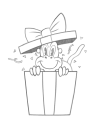DEADLINE: 12/02/2023 - PLEASE SUBMIT WORK BY 12/02/2023 IF YOU WANT A CHANCE TO BE FEATURED IN THE CRITIQUE VIDEO
It’s time for your assignment!
Your first step to making your own comic page is to piece together your layout with thumbnails. You’ll be making a lot of decisions here so keep your sketches simple and focus on how you can enhance the storytelling visually.
Use the scripts we provided and try out several different layouts for each, piecing together your thumbnails like a puzzle. Even without any drawings in them, the panels should flow from one to the next, and read in the correct order that you intended. Working at a small size will help you see larger storytelling problems before moving on, so If anything is feeling ambiguous, try another layout.
Once you’ve chosen your favorite layouts, it's time to draw a reduced-size layout for those pages! For the reduced-size-layout, draw it at about one-third the size of a page, or about four inches by six inches. Draw in your panels first with a ruler, and don’t forget to account for the trim and panel border safe zone at the edges. Then go over your scripts again to make sure the important details are included in your page. Start with a rough-in that lets you place all the elements in each panel, and then clean it up. Don’t go overboard with the details at this stage, just make it as clear and readable as possible so we don’t cause any problems for ourselves when we move to the full-sized page.
If you’re working on a page from a different script, be sure to include that script in your submissions so we can see what you’re working with. Good luck!




